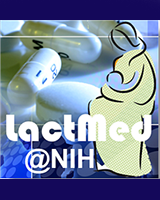Attribution Statement: LactMed is a registered trademark of the U.S. Department of Health and Human Services.
NCBI Bookshelf. A service of the National Library of Medicine, National Institutes of Health.
Drugs and Lactation Database (LactMed®) [Internet]. Bethesda (MD): National Institute of Child Health and Human Development; 2006-.
CASRN: 80-08-0

Drug Levels and Effects
Summary of Use during Lactation
Dapsone can be used during breastfeeding; however, hemolytic anemia might occur, especially in newborn infants and in those with glucose-6-phosphate dehydrogenase (G6PD) deficiency. The time of greatest risk for hemolysis in fullterm newborns without G6PD deficiency might be as short as 8 days after birth.[1] One source states that use of dapsone in the treatment of leprosy is advantageous because it kills the organisms in breastmilk.[2] Monitor the infant for signs of hemolysis, especially in newborn or premature breastfed infants.
Topical dapsone gel used to treat acne has not been studied during breastfeeding. According to the manufacturer, topical dapsone gel results in a blood level of 1% that of a 100 mg oral dose. It is unlikely that the topical gel would affect the breastfed infant, but the manufacturer states that it should not be used during nursing. Until more data are available, an alternative topical agent might be preferred.
Drug Levels
Maternal Levels. In one mother who was 41 days postpartum, a random milk level of dapsone was about 1.1 mg/L with a maternal dose of 50 mg daily. Monoacetyldapsone was not detectable in milk although the maternal serum level was 744 mcg/L.[3]
Three women who were 2 to 5 days postpartum were given a single dose of 100 mg of dapsone orally. Milk samples were obtained at various times up to about 220 hours after the dose. The authors calculated that the breastfed infants would receive an average of 9.6% (range 4.6 to 14.3%) of the maternal weight-adjusted dosage.[4]
Infant Levels. A mother who was 41 days postpartum was taking dapsone 50 mg daily. Her breastfed infant's serum had levels of 439 mcg/L of dapsone and 204 mcg/L of monoacetyldapsone.[3]
Effects in Breastfed Infants
A case of mild hemolytic anemia occurred in a 41-day-old breastfed infant whose mother was taking dapsone 50 mg daily. The hemolysis was probably caused by dapsone in milk.[3]
A woman with leprosy took dapsone, clofazimine and rifampin during pregnancy and breastfeeding. Her infant developed skin discoloration attributed to clofazimine which reversed 3 months after cessation of breastfeeding.[5]
Effects on Lactation and Breastmilk
Relevant published information was not found as of the revision date.
Alternate Drugs to Consider
(Leprosy) Clofazimine; (Topical for Acne) Adapalene; Azelaic Acid; Benzoyl Peroxide; Clindamycin; Erythromycin; Tretinoin
References
- 1.
- Zao J, Koren G, Bozzo P. Using nitrofurantoin while breastfeeding a newborn. Can Fam Physician. 2014;60:539-40. [PMC free article: PMC4055319] [PubMed: 24925943]
- 2.
- Jopling WH. Handbook of leprosy. 3rd Ed. London: Heinemann Medical Books Ltd. 1984:86-7.
- 3.
- Sanders SW, Zone JJ, Foltz RL et al. Hemolytic anemia induced by dapsone transmitted through breast milk. Ann Intern Med. 1982;96:465-6. [PubMed: 7065565]
- 4.
- Edstein MD, Veenendaal JR, Newman K, Hyslop R. Excretion of chloroquine, dapsone and pyrimethamine in human milk. Br J Clin Pharmacol. 1986;22:733-5. [PMC free article: PMC1401222] [PubMed: 3567020]
- 5.
- Ozturk Z, Tatliparmak A. Leprosy treatment during pregnancy and breastfeeding: A case report and brief review of literature. Dermatol Ther. 2017;30:e12414. [PubMed: 27549245]
Substance Identification
Substance Name
Dapsone
CAS Registry Number
80-08-0
Drug Class
- Breast Feeding
- Anti-Infective Agents
- Leprostatic Agents
Disclaimer: Information presented in this database is not meant as a substitute for professional judgment. You should consult your healthcare provider for breastfeeding advice related to your particular situation. The U.S. government does not warrant or assume any liability or responsibility for the accuracy or completeness of the information on this Site.
- User and Medical Advice Disclaimer
- Drugs and Lactation Database (LactMed) - Record Format
- LactMed - Database Creation and Peer Review Process
- Fact Sheet. Drugs and Lactation Database (LactMed)
- Drugs and Lactation Database (LactMed) - Glossary
- LactMed Selected References
- Drugs and Lactation Database (LactMed) - About Dietary Supplements
- Breastfeeding Links
- PMCPubMed Central citations
- PubChem SubstanceRelated PubChem Substances
- PubMedLinks to PubMed
- Review Trientine.[Drugs and Lactation Database (...]Review Trientine.. Drugs and Lactation Database (LactMed®). 2006
- Review Sulfamethoxazole.[Drugs and Lactation Database (...]Review Sulfamethoxazole.. Drugs and Lactation Database (LactMed®). 2006
- [DIAPHENYLSULFONE; bis(4-aminophenyl) sulfone; 4,4-diamino diphenyl-sulfone].[Ann Pharm Fr. 1959][DIAPHENYLSULFONE; bis(4-aminophenyl) sulfone; 4,4-diamino diphenyl-sulfone].. Ann Pharm Fr. 1959 Mar; 17:228-31.
- Review Sulfasalazine.[Drugs and Lactation Database (...]Review Sulfasalazine.. Drugs and Lactation Database (LactMed®). 2006
- Review Phenazopyridine.[Drugs and Lactation Database (...]Review Phenazopyridine.. Drugs and Lactation Database (LactMed®). 2006
- Dapsone - Drugs and Lactation Database (LactMed®)Dapsone - Drugs and Lactation Database (LactMed®)
Your browsing activity is empty.
Activity recording is turned off.
See more...
